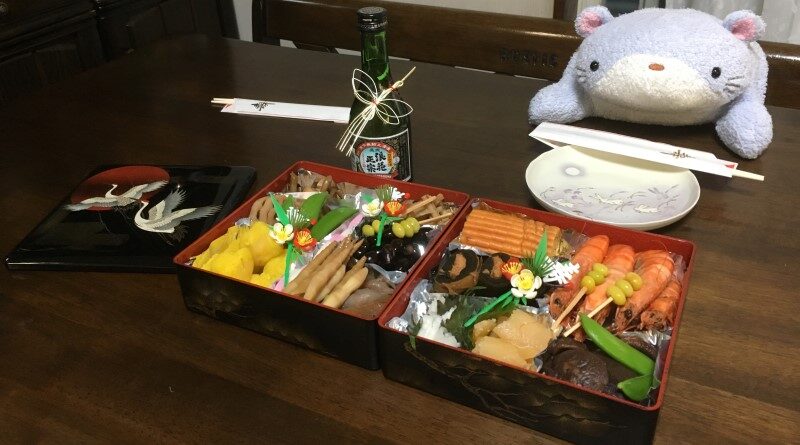Osechi Ryori: Traditional New Year’s Japanese Food
Japan has dozens of festivals and holidays throughout the year, however, O-Shogatsu, or New Year’s, is easily the most important. Of course the highlight of any big event is going to be the food, and Osechi ryori [お節料理] is without a doubt a star.

The Origins of Osechi Ryori
The First Osechi Ryori
The common man did not start eating osechi ryori themselves until the start of the Meiji Period. As more kinds of food became more abundant, osechi dishes started to evolve into more like what is osechi ryori today. Since stores were often (and still are) closed New Year’s Day and several days thereafter, the food for osechi ryori was made in advance and would gradually be eaten throughout the first week of the New Year. This is why osechi ryori is always served cold and many osechi dishes are preserved or sweetened to help keep the food from spoiling.
Since osechi dishes are preserved, the process of making each individual morsels takes a lot of time. Kombumaki for example, can take days to prepare, and it is just one of many essential parts of osechi ryori. All of the individual dishes of osechi ryori hold a different meaning, such as good fortune, happiness and wealth.
Also, roughly around the start of the Meiji Period is when osechi started being served in a layered lacquered boxes called a jubako [重箱]. These boxes traditionally came in sets of five or four, though now two or three is more common. You will never see a single jubako because the stack of jubako represent long life as the verb for counting boxes, kasaneru, is the same as counting the years of one’s life.
Osechi Ryori Today
Today, most Japanese families do not have the time to make osechi ryori and instead order it, either from a department store, local super market, and yes, even convenience stores offer osechi ryori. Because each main ingredient of the osechi dishes is supposed to be a certain size or quality, as well as the tremendous amount of time it takes just to make one dish, osechi does not come cheap. Even the cheapest sets for two people can easily run 2—300 dollars, with the most expensive ones climbing in to the tens of thousands.
What Makes Osechi Ryori?
While the individual parts of osechi ryori can change depending on region, and you don’t have to absolutely have all of the osechi dishes possible, however, you will usually find at least the following:

Inside the Jubako
Datemaki: Represents education. The rolled shape of this almost cake like rolled omelet looks like rolled scrolls.

Kuri-kinton: Represents wealth. These are little balls of sweet potato get their bright yellow from soaking them with the dried fruit of a kuchinashi (a kind of jasmine). The balls contain a chestnut in the middle.
Kamaboko: Represents the sunrise. A kind of fishcake that is available year round. The pink color represents happiness and the white, purity.
Konbumaki: Represents happiness and long life. Konbu sounds like the “kobu” of yorokobu meaning happiness. Either preserved fish or cooked fish egg sacks wrapped in seasoned kelp.
Kazunoko: Represents fertility. Herring roe. “Kazu” means number(s) and “ko” means children and the word for herring nishin 鰊 coincidentally is similar to another nishin 二親 made of the characters for “two” and “parent”.

Kuromame: Represents hard-work. Kuromame are black soy beans. “Mame” means bean, but it also is part of expression “Mame mame shiku hataraku” which encourages hard work. They get a bright luster from boiling them with a rusty nail and a pinch of baking soda.
Tataki Gobo: Represents strength. Gobo, or burdock root, is a very hard, sturdy vegetable that is difficult to pull out of the ground. After simmering the burdock in soy sauce and mirin. The tataki part of the name comes from pounding the gobo after simmering it. Finally it is topped with ground sesame seeds.

Kuwai: Represents fertility. Kuwai is kind of water chestnut. The long stalk important part of the presentation.
Ebi: Represents longevity. The “c” shape of shrimp is similar to a hunched over elderly person. It is the hope that you will also reach a ripe old age when you eat this as part of osechi royori.
Additional New Year’s Dishes
In addition to those dishes, there are other additional foods at O-Shogatsu as well, but are technically not part of osechi ryori.
O-zoni

A special New Year’s Day soup. O-zoni has several regional variations however, Kanto–style sumashi, and Osaka–style shiro-miso are predominately eaten throughout Japan. Sumashi is a clear broth, again there are many variations of the both, served with a piece of chicken, leafy vegetable, and a piece of square, grilled mochi.
Osaka’s shiro-miso is very white and tastes very different from your everyday miso. This shiro-miso is creamy and almost has a sweet taste. Also notably different from shumashi is the inclusion mochi.
Mochi

Not really osechi ryori, but mochi is very common in Japan around O-Shogatsu. The stretching of the mochi represents long life.
Mochi is traditionally prepared with a big mallet and a stone bowl. There are probably a number of places you can find that do traditional mochi tsuki, but I think most people will buy pre-made dried mochi. However, they could, like my mother-in-law, have a mochi machine and just make it yourself without the heavy lifting.


Leave a Reply